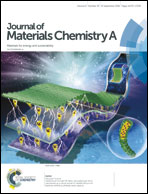Carboxylate substitution position influencing polymer properties and enabling non-fullerene organic solar cells with high open circuit voltage and low voltage loss†
Abstract
To minimize the voltage loss of non-fullerene organic solar cells (OSCs), it is important to modulate the energy levels of active materials and thus the photovoltage of the device. In this paper, we report a simple and effective approach to tune the energy levels of a state-of-the-art polymer P3TEA by switching the position of alkyl side chains and carboxylate substituents on the polymer backbone. The resulting polymer P3TAE exhibits a deep highest occupied molecular orbital (HOMO) level, contributing to a high open circuit voltage (VOC) of 1.20 V and a small voltage loss of 0.54 V when it is blended with a small molecule acceptor (SMA) FTTB-PDI4. Despite a small charge separation driving force, the P3TAE:FTTB-PDI4 blend exhibits efficient charge extraction, supported by relatively high external quantum efficiency (EQE) (∼60%) in the corresponding device. In addition, the P3TAE:FTTB-PDI4 blend shows relatively high electron mobility and domain purity, leading to a high fill factor (FF) in the device. As a result, the P3TAE:FTTB-PDI4-based solar cell exhibits a power conversion efficiency (PCE) of 8.10%, which is one of the highest achieved performances for single-junction OSCs with VOC higher than 1.20 V.



 Please wait while we load your content...
Please wait while we load your content...